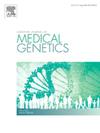Diagnostic yield of whole exome sequencing in a cohort of 825 patients
IF 1.7
4区 医学
Q3 GENETICS & HEREDITY
引用次数: 0
Abstract
Genetic testing plays a significant role in rare disease diagnostics. The most widespread technology for genetic testing of patients is next generation sequencing or second-generation sequencing, including whole exome sequencing (WES). Our laboratory performed diagnostic WES on 1660 samples representing 825 index patients aged 0–84 years between 2014 and 2020. The cohort is comprised of consecutive patients with a rare disease referred for diagnostic WES with analysis of all known disease genes. The main referrals were paediatric, clinical genetic and adult neurology departments.
Patients’ symptoms were translated to terms in the Human Phenotype Ontology (HPO) system and each symptom assigned to a single top-level HPO term. Variants were classified according to ACMG-AMP guidelines.
The diagnostic yield in this cohort was 33.7 % with 278 patients receiving a genetic diagnosis.
Patients with complex phenotypes with involvement of several organ systems were more likely to receive a genetic diagnosis. Higher diagnostic yields were seen for phenotypes including growth abnormalities, abnormalities of the ear or of the musculoskeletal system as well.
825例患者全外显子组测序的诊断率。
基因检测在罕见病诊断中发挥着重要作用。最广泛的患者基因检测技术是下一代测序或第二代测序,包括全外显子组测序(WES)。本实验室于2014 - 2020年间对825例0-84岁指标患者的1660份样本进行了诊断性WES。该队列由连续的罕见疾病患者组成,这些患者被转诊进行WES诊断,并对所有已知的疾病基因进行分析。主要转诊为儿科、临床遗传科和成人神经科。患者的症状被翻译成人类表型本体(HPO)系统中的术语,每个症状被分配到单个顶级HPO术语。根据ACMG-AMP指南对变异进行分类。该队列中接受基因诊断的278例患者的诊断率为33.7%。具有复杂表型并涉及多个器官系统的患者更有可能接受基因诊断。对于包括生长异常、耳朵或肌肉骨骼系统异常在内的表型,更高的诊断率也被观察到。
本文章由计算机程序翻译,如有差异,请以英文原文为准。
求助全文
约1分钟内获得全文
求助全文
来源期刊
CiteScore
4.10
自引率
0.00%
发文量
193
审稿时长
66 days
期刊介绍:
The European Journal of Medical Genetics (EJMG) is a peer-reviewed journal that publishes articles in English on various aspects of human and medical genetics and of the genetics of experimental models.
Original clinical and experimental research articles, short clinical reports, review articles and letters to the editor are welcome on topics such as :
• Dysmorphology and syndrome delineation
• Molecular genetics and molecular cytogenetics of inherited disorders
• Clinical applications of genomics and nextgen sequencing technologies
• Syndromal cancer genetics
• Behavioral genetics
• Community genetics
• Fetal pathology and prenatal diagnosis
• Genetic counseling.

 求助内容:
求助内容: 应助结果提醒方式:
应助结果提醒方式:


